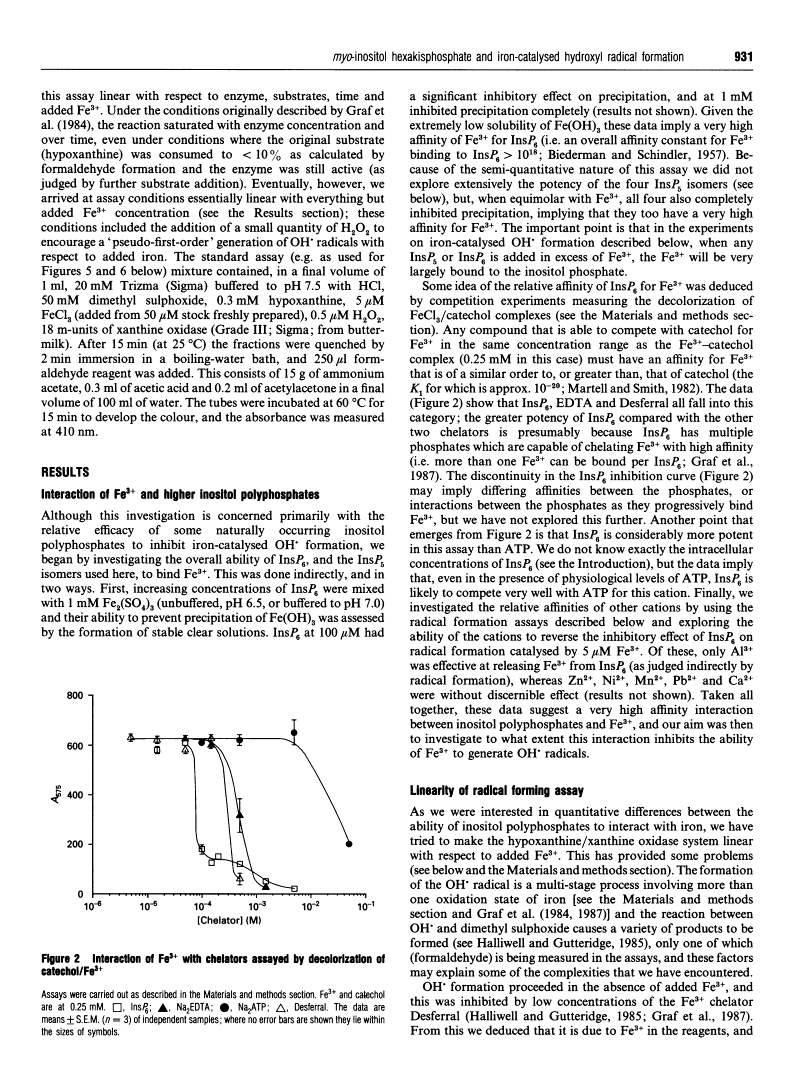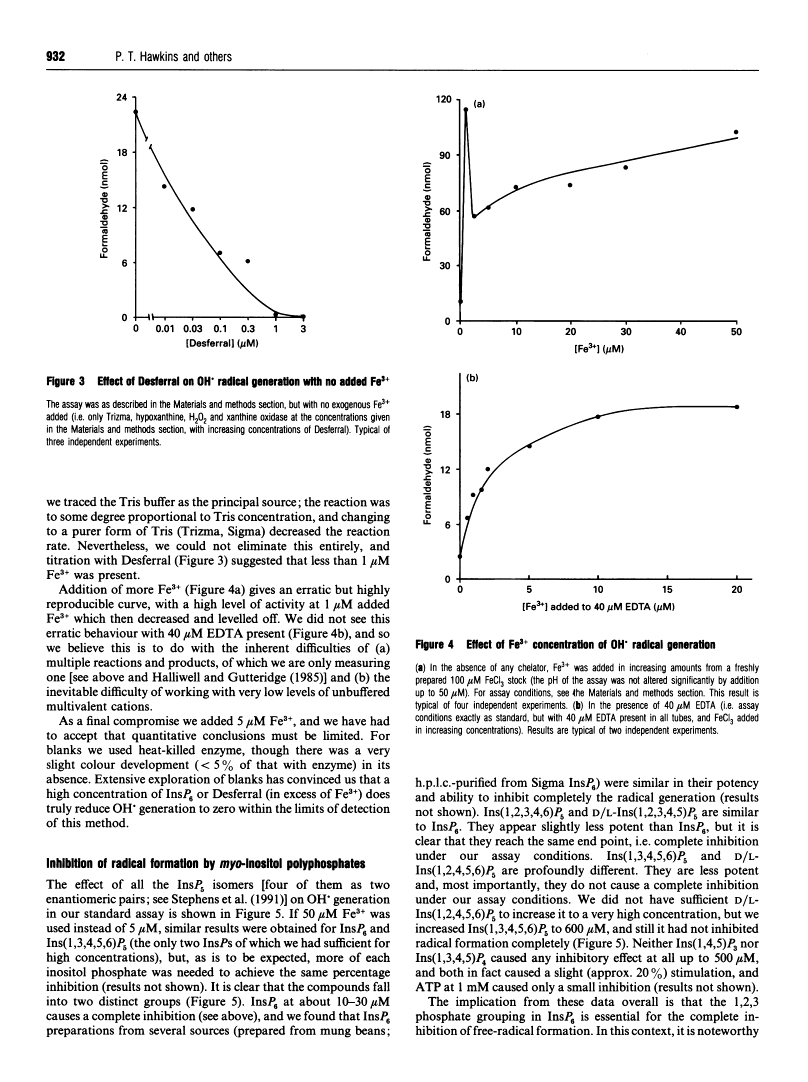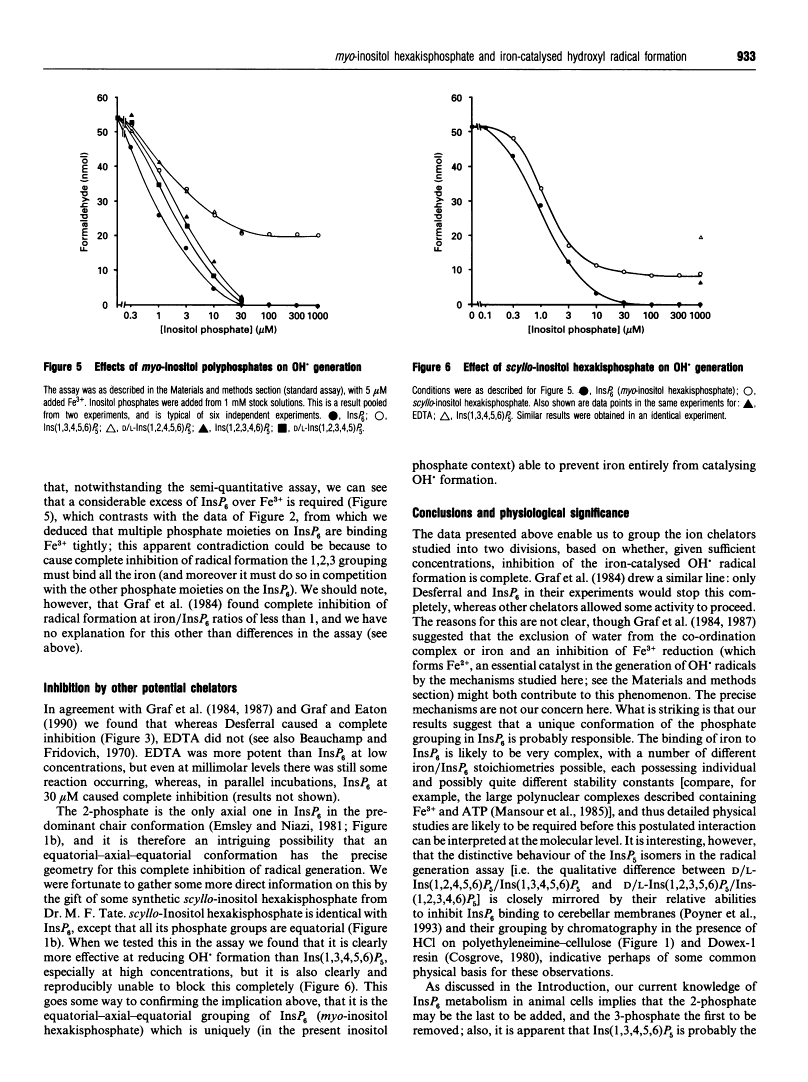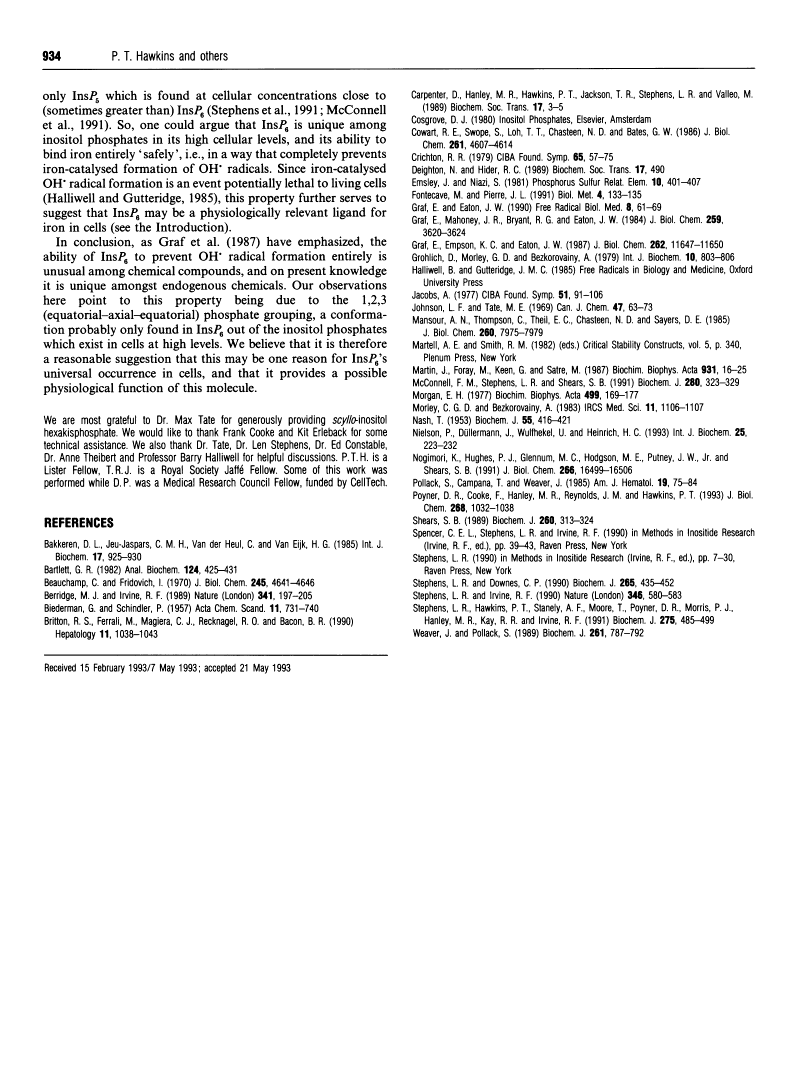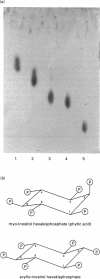Abstract
Free full text

Inhibition of iron-catalysed hydroxyl radical formation by inositol polyphosphates: a possible physiological function for myo-inositol hexakisphosphate.
Abstract
1. The ability of myo-inositol polyphosphates to inhibit iron-catalysed hydroxyl radical formation was studied in a hypoxanthine/xanthine oxidase system [Graf, Empson and Eaton (1987) J. Biol. Chem. 262, 11647-11650]. Fe3+ present in the assay reagents supported some radical formation, and a standard assay, with 5 microM Fe3+ added, was used to investigate the specificity of compounds which could inhibit radical generation. 2. InsP6 (phytic acid) was able to inhibit radical formation in this assay completely. In this respect it was similar to the effects of the high affinity Fe3+ chelator Desferral, and dissimilar to the effects of EDTA which, even at high concentrations, still allowed detectable radical formation to take place. 3. The six isomers of InsP5 were purified from an alkaline hydrolysate of InsP6 (four of them as two enantiomeric mixtures), and they were compared with InsP6 in this assay. Ins(1,2,3,4,6)P5 and D/L-Ins(1,2,3,4,5)P5 were similar to InsP6 in that they caused a complete inhibition of iron-catalysed radical formation at > 30 microM. Ins(1,3,4,5,6)P5 and D/L-Ins(1,2,4,5,6)P5, however, were markedly less potent than InsP6, and did not inhibit radical formation completely; even when Ins(1,3,4,5,6)P5 was added up to 600 microM, significant radical formation was still detected. Thus InsP5s lacking 2 or 1/3 phosphates are in this respect qualitatively different from InsP6 and the other InsP5s. 4. scyllo-Inositol hexakisphosphate was also tested, and although it caused a greater inhibition than Ins(1,3,4,5,6)P5, it too still allowed detectable free radical formation even at 600 microM. 5. We conclude that the 1,2,3 (equatorial-axial-equatorial) phosphate grouping in InsP6 has a conformation that uniquely provides a specific interaction with iron to inhibit totally its ability to catalyse hydroxyl radical formation; we suggest that a physiological function of InsP6 might be to act as a 'safe' binding site for iron during its transport through the cytosol or cellular organelles.
Full text
Full text is available as a scanned copy of the original print version. Get a printable copy (PDF file) of the complete article (1.3M), or click on a page image below to browse page by page. Links to PubMed are also available for Selected References.
Images in this article
Click on the image to see a larger version.
Selected References
These references are in PubMed. This may not be the complete list of references from this article.
- Bakkeren DL, de Jeu-Jaspars CM, van der Heul C, van Eijk HG. Analysis of iron-binding components in the low molecular weight fraction of rat reticulocyte cytosol. Int J Biochem. 1985;17(8):925–930. [Abstract] [Google Scholar]
- Bartlett GR. Isolation and assay of red-cell inositol polyphosphates. Anal Biochem. 1982 Aug;124(2):425–431. [Abstract] [Google Scholar]
- Beauchamp C, Fridovich I. A mechanism for the production of ethylene from methional. The generation of the hydroxyl radical by xanthine oxidase. J Biol Chem. 1970 Sep 25;245(18):4641–4646. [Abstract] [Google Scholar]
- Berridge MJ, Irvine RF. Inositol phosphates and cell signalling. Nature. 1989 Sep 21;341(6239):197–205. [Abstract] [Google Scholar]
- Britton RS, Ferrali M, Magiera CJ, Recknagel RO, Bacon BR. Increased prooxidant action of hepatic cytosolic low-molecular-weight iron in experimental iron overload. Hepatology. 1990 Jun;11(6):1038–1043. [Abstract] [Google Scholar]
- Carpenter D, Hanley MR, Hawkins PT, Jackson TR, Stephens LR, Vallejo M. The metabolism and functions of inositol pentakisphosphate and inositol hexakisphosphate. Biochem Soc Trans. 1989 Feb;17(1):3–5. [Abstract] [Google Scholar]
- Cowart RE, Swope S, Loh TT, Chasteen ND, Bates GW. The exchange of Fe3+ between pyrophosphate and transferrin. Probing the nature of an intermediate complex with stopped flow kinetics, rapid multimixing, and electron paramagnetic resonance spectroscopy. J Biol Chem. 1986 Apr 5;261(10):4607–4614. [Abstract] [Google Scholar]
- Crichton RR. Interactions between iron metabolism and oxygen activation. Ciba Found Symp. 1978 Jun 6;(65):57–76. [Abstract] [Google Scholar]
- Fontecave M, Pierre JL. Iron metabolism: the low-molecular-mass iron pool. Biol Met. 1991;4(3):133–135. [Abstract] [Google Scholar]
- Graf E, Eaton JW. Antioxidant functions of phytic acid. Free Radic Biol Med. 1990;8(1):61–69. [Abstract] [Google Scholar]
- Graf E, Mahoney JR, Bryant RG, Eaton JW. Iron-catalyzed hydroxyl radical formation. Stringent requirement for free iron coordination site. J Biol Chem. 1984 Mar 25;259(6):3620–3624. [Abstract] [Google Scholar]
- Graf E, Empson KL, Eaton JW. Phytic acid. A natural antioxidant. J Biol Chem. 1987 Aug 25;262(24):11647–11650. [Abstract] [Google Scholar]
- Herzberg GR. Purification and properties of liver phosphofructokinase from normal and obese mice. Int J Biochem. 1979;10(10):803–806. [Abstract] [Google Scholar]
- Jacobs A. An intracellular transit iron pool. Ciba Found Symp. 1976 Dec 7;(51):91–106. [Abstract] [Google Scholar]
- Mansour AN, Thompson C, Theil EC, Chasteen ND, Sayers DE. Fe(III).ATP complexes. Models for ferritin and other polynuclear iron complexes with phosphate. J Biol Chem. 1985 Jul 5;260(13):7975–7979. [Abstract] [Google Scholar]
- Martin JB, Foray MF, Klein G, Satre M. Identification of inositol hexaphosphate in 31P-NMR spectra of Dictyostelium discoideum amoebae. Relevance to intracellular pH determination. Biochim Biophys Acta. 1987 Oct 22;931(1):16–25. [Abstract] [Google Scholar]
- McConnell FM, Stephens LR, Shears SB. Multiple isomers of inositol pentakisphosphate in Epstein-Barr-virus- transformed (T5-1) B-lymphocytes. Identification of inositol 1,3,4,5,6-pentakisphosphate, D-inositol 1,2,4,5,6-pentakisphosphate and L-inositol 1,2,4,5,6-pentakisphosphate. Biochem J. 1991 Dec 1;280(Pt 2):323–329. [Europe PMC free article] [Abstract] [Google Scholar]
- Morgan EH. Iron exchange between transferrin molecules mediated by phosphate compounds and other cell metabolites. Biochim Biophys Acta. 1977 Aug 25;499(1):169–177. [Abstract] [Google Scholar]
- NASH T. The colorimetric estimation of formaldehyde by means of the Hantzsch reaction. Biochem J. 1953 Oct;55(3):416–421. [Europe PMC free article] [Abstract] [Google Scholar]
- Nielsen P, Düllmann J, Wulfhekel U, Heinrich HC. Non-transferrin-bound-iron in serum and low-molecular-weight-iron in the liver of dietary iron-loaded rats. Int J Biochem. 1993 Feb;25(2):223–232. [Abstract] [Google Scholar]
- Nogimori K, Hughes PJ, Glennon MC, Hodgson ME, Putney JW, Jr, Shears SB. Purification of an inositol (1,3,4,5)-tetrakisphosphate 3-phosphatase activity from rat liver and the evaluation of its substrate specificity. J Biol Chem. 1991 Sep 5;266(25):16499–16506. [Abstract] [Google Scholar]
- Pollack S, Campana T, Weaver J. Low molecular weight iron in guinea pig reticulocytes. Am J Hematol. 1985 May;19(1):75–84. [Abstract] [Google Scholar]
- Poyner DR, Cooke F, Hanley MR, Reynolds DJ, Hawkins PT. Characterization of metal ion-induced [3H]inositol hexakisphosphate binding to rat cerebellar membranes. J Biol Chem. 1993 Jan 15;268(2):1032–1038. [Abstract] [Google Scholar]
- Shears SB. Metabolism of the inositol phosphates produced upon receptor activation. Biochem J. 1989 Jun 1;260(2):313–324. [Europe PMC free article] [Abstract] [Google Scholar]
- Stephens LR, Downes CP. Product-precursor relationships amongst inositol polyphosphates. Incorporation of [32P]Pi into myo-inositol 1,3,4,6-tetrakisphosphate, myo-inositol 1,3,4,5-tetrakisphosphate, myo-inositol 3,4,5,6-tetrakisphosphate and myo-inositol 1,3,4,5,6-pentakisphosphate in intact avian erythrocytes. Biochem J. 1990 Jan 15;265(2):435–452. [Europe PMC free article] [Abstract] [Google Scholar]
- Stephens LR, Irvine RF. Stepwise phosphorylation of myo-inositol leading to myo-inositol hexakisphosphate in Dictyostelium. Nature. 1990 Aug 9;346(6284):580–583. [Abstract] [Google Scholar]
- Stephens LR, Hawkins PT, Stanley AF, Moore T, Poyner DR, Morris PJ, Hanley MR, Kay RR, Irvine RF. myo-inositol pentakisphosphates. Structure, biological occurrence and phosphorylation to myo-inositol hexakisphosphate. Biochem J. 1991 Apr 15;275(Pt 2):485–499. [Europe PMC free article] [Abstract] [Google Scholar]
- Weaver J, Pollack S. Low-Mr iron isolated from guinea pig reticulocytes as AMP-Fe and ATP-Fe complexes. Biochem J. 1989 Aug 1;261(3):787–792. [Europe PMC free article] [Abstract] [Google Scholar]
Associated Data
Articles from Biochemical Journal are provided here courtesy of The Biochemical Society
Full text links
Read article at publisher's site: https://doi.org/10.1042/bj2940929
Read article for free, from open access legal sources, via Unpaywall:
https://europepmc.org/articles/pmc1134551?pdf=render
Citations & impact
Impact metrics
Article citations
The Relevance of Phytate for the Treatment of Chronic Kidney Disease.
Clin J Am Soc Nephrol, 19(10):1341-1355, 07 Aug 2024
Cited by: 0 articles | PMID: 39110986
Review
Oral phytate supplementation on the progression of mild cognitive impairment, brain iron deposition and diabetic retinopathy in patients with type 2 diabetes: a concept paper for a randomized double blind placebo controlled trial (the PHYND trial).
Front Endocrinol (Lausanne), 15:1332237, 30 May 2024
Cited by: 2 articles | PMID: 38872972
Antimicrobial Activity of Phytic Acid: An Emerging Agent in Endodontics.
Front Cell Infect Microbiol, 11:753649, 26 Oct 2021
Cited by: 10 articles | PMID: 34765567 | PMCID: PMC8576384
MINPP1 prevents intracellular accumulation of the chelator inositol hexakisphosphate and is mutated in Pontocerebellar Hypoplasia.
Nat Commun, 11(1):6087, 30 Nov 2020
Cited by: 24 articles | PMID: 33257696 | PMCID: PMC7705663
Polyphosphate Functions In Vivo as an Iron Chelator and Fenton Reaction Inhibitor.
mBio, 11(4):e01017-20, 28 Jul 2020
Cited by: 31 articles | PMID: 32723918 | PMCID: PMC7387796
Go to all (73) article citations
Data
Data behind the article
This data has been text mined from the article, or deposited into data resources.
BioStudies: supplemental material and supporting data
Similar Articles
To arrive at the top five similar articles we use a word-weighted algorithm to compare words from the Title and Abstract of each citation.
Stepwise phosphorylation of myo-inositol leading to myo-inositol hexakisphosphate in Dictyostelium.
Nature, 346(6284):580-583, 01 Aug 1990
Cited by: 107 articles | PMID: 2198472
Inhibition of clathrin assembly by high affinity binding of specific inositol polyphosphates to the synapse-specific clathrin assembly protein AP-3.
J Biol Chem, 270(4):1564-1568, 01 Jan 1995
Cited by: 99 articles | PMID: 7829485
Metabolism of inositol phosphates in the protozoan Paramecium. Characterization of a novel inositol-hexakisphosphate-dephosphorylating enzyme.
Eur J Biochem, 207(1):359-367, 01 Jul 1992
Cited by: 16 articles | PMID: 1628659
Inositol phosphates and cell signaling: new views of InsP5 and InsP6.
Trends Biochem Sci, 18(2):53-56, 01 Feb 1993
Cited by: 61 articles | PMID: 8387704
Review


